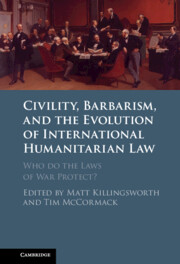 Civility, Barbarism and the Evolution of International Humanitarian Law
Civility, Barbarism and the Evolution of International Humanitarian Law Book contents
- Civility, Barbarism, and the Evolution of International Humanitarian Law
- Civility, Barbarism, and the Evolution of International Humanitarian Law
- Copyright page
- Contents
- Contributors
- Preface and Acknowledgements
- Abbreviations
- 1 Introduction
- 2 Sieges and the Laws of War in Europe’s Long Eighteenth Century
- 3 All’s Fair in Love and War or the Limits of the Limitations
- 4 Cultivating Humanitarianism
- 5 Limits to the Scope of Humanity as a Constraint on the Conduct of War
- 6 The State, Civility, and International Humanitarian Law
- 7 Operationalising Distinction in South Sudan
- 8 Private Military and Security Companies and International Humanitarian Law
- 9 Protecting Warfighters from Superfluous Injury and Unnecessary Suffering
- 10 Blurring the Lines
- 11 A Step Back to Take a Step Forward
- Index
- References
5 - Limits to the Scope of Humanity as a Constraint on the Conduct of War
Published online by Cambridge University Press: 11 January 2024
- Civility, Barbarism, and the Evolution of International Humanitarian Law
- Civility, Barbarism, and the Evolution of International Humanitarian Law
- Copyright page
- Contents
- Contributors
- Preface and Acknowledgements
- Abbreviations
- 1 Introduction
- 2 Sieges and the Laws of War in Europe’s Long Eighteenth Century
- 3 All’s Fair in Love and War or the Limits of the Limitations
- 4 Cultivating Humanitarianism
- 5 Limits to the Scope of Humanity as a Constraint on the Conduct of War
- 6 The State, Civility, and International Humanitarian Law
- 7 Operationalising Distinction in South Sudan
- 8 Private Military and Security Companies and International Humanitarian Law
- 9 Protecting Warfighters from Superfluous Injury and Unnecessary Suffering
- 10 Blurring the Lines
- 11 A Step Back to Take a Step Forward
- Index
- References
Summary
Accounts of the historical origins of international humanitarian law (IHL) routinely assume that the emergence of humanity as a constraint on the waging of war, coinciding as it did with a general rise of humanitarianism in the nineteenth century, reflected a growing commitment to a universally shared notion of human dignity. That assumption is fallacious. Those who have been mythologised as champions of humanity as constraint, including Henri Dunant and Francis Lieber, were products of their era. IHL’s ‘original sin’ was to only extend constraints of humanity to so-called civilised nations in their wars inter se. These same constraints were not intended to apply to indigenous and other colonised populations – those assumed to be ‘uncivilised’ – often referred to as such with the pejoratives ‘savages’ and/or ‘barbarians’. The exclusion of emergent constraints on the grounds of racism and colonialism is evident in the language of the early IHL treaties. It has taken many decades for the international community to overcome the exclusions of the legal protection of emergent IHL and some would argue that the tendency for exclusion is still evident in the dehumanising of the other in the Global War on Terror.
Keywords
- Type
- Chapter
- Information
- Civility, Barbarism and the Evolution of International Humanitarian LawWho do the Laws of War Protect?, pp. 85 - 110Publisher: Cambridge University PressPrint publication year: 2024
